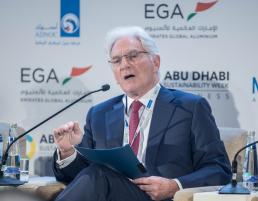The renewable energy industry is bracing itself for a critical year of positive activity in 2017 as key markets across the Gulf and wider Middle East and North Africa (MENA) accelerate their energy diversification programmes to meet national targets, according to Dr. Nasser Saidi, Chairman of the Clean Energy Business Council (CEBC).
Speaking ahead of CEBC’s fifth annual Clean Energy Summit taking place tomorrow (Wednesday 14th), Dr. Saidi said developers and financiers will head into 2017 full of expectations that the region’s shift to low carbon energy sources will accelerate, led by markets such as Saudi Arabia. In line with the Kingdom’s National Transformation Plan, Saudi Arabia plans to install 3.5GW of renewables by 2020.
“2016 has been a positive year in which record low bids for utility scale solar power, primarily in the UAE, have positively and irreversibly changed the dynamic of solar,” said Dr. Nasser Saidi. “But this is only the beginning of what we believe to be a paradigm shift in the pace of clean energy deployment in this region.
“Next year will be critical to the long term success of the energy diversification strategies across the Middle East, as we close in on the 2020 milestone,” continued Dr. Saidi. “What we see from markets such as Saudi Arabia in particular during the early part of 2017 will be a key indicator of renewed momentum – beyond 2017 – leading a major shift in the regional dynamic for renewables for the next decade and beyond.”
Kuwait and Bahrain are targeting five percent of installed capacity from renewables by the same date. The United Arab Emirates plans to derive 21 percent of its power from clean sources by 2021. Jordan will connect 1,800 MW of renewable power to its national grid by the end of 2018 and Egypt plans to raise its share of renewable energy to 20 percent by 2022. In addition, Morocco is expected to have 42 percent of its installed energy capacity from renewable sources by 2020.
Thierry Tardy, Executive Director, Acquisitions and Project Finance, ACWA Power – a sponsor of the MENA Clean Energy Summit said, “Renewable energy sources are more cost-competitive than ever, and the Middle East, driven by the GCC, has tripled its investments in renewables from 2015. As a partner to governments in the UAE, Morocco, Jordan and South Africa, ACWA Power will continue to help the GCC realize its energy capacity of 80GW by 2030, reduce CO2 emissions, and create sustainable jobs in the field of clean energy in 2017 and beyond. This year’s Clean Energy Summit is an opportunity for us all to reaffirm the region’s clean energy roadmap, and set an actionable example for the rest of the world.”
The CEBC summit will focus on scaling up Utility Scale Solar and Distributed/Rooftop Solar – where we are now and what’s next for the region including:
- Increasing deployment of CSP (concentrated solar power) technology and the role of energy storage
- Overview and analysis of financing utility scale solar and the key differences and challenges between financing CSP and PV(photovoltaic) projects
- Phasing out subsidies and how solar can benefit from development in a subsidy free environment
- Accessing affordable finance for solar – securing a Low Carbon Future
- Understanding the economics around Net Metering and Wheeling Projects in Jordan and the value of storage
- Latest update on Saudi Arabia’s renewable energy strategy and future plans
- Energy Efficiency and ESCO Models: the impact of increased electricity/fuel pricing across the GCC
- Practical advice for accelerating project implementation for distributed solar in the Residential, Commercial & Industrial Sectors
Estimates suggest the Middle East region as a whole requires an additional 267 gigawatts (GW) of power supply by 2030 to meet rising energy demands.



